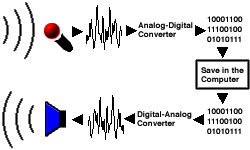Sound in the ComputerThere are normally two ways of working with sound in the computer.
- The first consists of recording, creating, editing and playing sounds
- The other consists of a type of synthesizer or sample-player on the soundcard in the machine, controlled by MIDI from a keyboard or a sequncing program.


In order to record sound into a computer we must have an analog-to-digital converter, often called an A/D converter. This works like a translator, measuring the electric sound signal from the microphone or another instrument and delivering the result of the measurements as a long series of numbers. This is also called sampling. Measurements are made up to 44,100 times per second and the value is described in up to 16 bits. This is the same format as the sound in a CD player.
In order to play the sounds back we must have a digital-to-analog converter - a D/A converter. This translates the stream of data into electronic signals that can be heard using playback equipment (the speakers in a computer, for example). These converters are built into some computers, while others require a sound card.
Sound is usually stored on the harddisk in the computer during recording. Large amounts of data amass quickly because the sound signal is measured tens of thousands of times per second on each channel. Stereo sound in CD format uses approximately 10 Mb per minute. Thus one needs a large and fast computer when recording on many channels.
When sound is sampled and stored in the computer there are many things that may be done with it, the simplest approach being "cut and paste." Since all sound editing programs display the sound curve on the screen, it is possible to edit much more precisely than when editing tape.
It is also possible to make sound directly in the computer, as demonstrated by the programs found in the sound menu of DSP.
It is also possible to process the sound; from simple operations such as adjusting the volume to advanced processes such as completely changing the timbre and pitch. The programs in the distortion and effects menu may be used for such purposes.
Most of the changes that are done using mixers and effect boxes may also be done with a computer. Adjustments may be made, for example, in the tone control, dynamics (the differece between strong and weak elements), reverb, voice and echo. Programs for this are also found under the effects menu.
Some programs do this while the machine is running. This is called processing in real time. In other programs we must wait until the sound files are finished being altered before we hear the result. On this CD-ROM, volume and panning are altered in real time, while all sound processing alters (or actually makes new) sound files.
There are other programs that both work with sound and are MIDI-controlled by synthesizers. Some of these programs can analyze the rhythm in a recorded soundtrack and adapt the MIDI data to follow the same rhythm. It is also possible to go the other way: to adjust (or quantify) the material according to the MIDI data!
Changing the tempo of a recording without changing the pitch, or changing the pitch without changing the tempo are other useful operations a computer can do.
Computers have replaced tape recorders and other equipment such as mixers and effect boxes in both home and professional sound studios. Most radio programs are also edited by computer, and the broadcast itself can be executed fairly automatically with all of the elements stored on disk.
Many sound cards contain what is a more or less advanced synthesizer, consisting of a chip that works with sound data. This chip often has a memory for prerecorded sounds (ROM), and a memory for sounds that can be downloaded to the card by the user (RAM)
Newer sound cards have enough space for RAM as well as for built-in sound effects such as reverb, etc. This allows one to work with sound in the same way as when using professional equipment.
The sound card is controlled by MIDI-instructions. These instructions may be sent by means of a keyboard, a controller or a program in the computer.
|